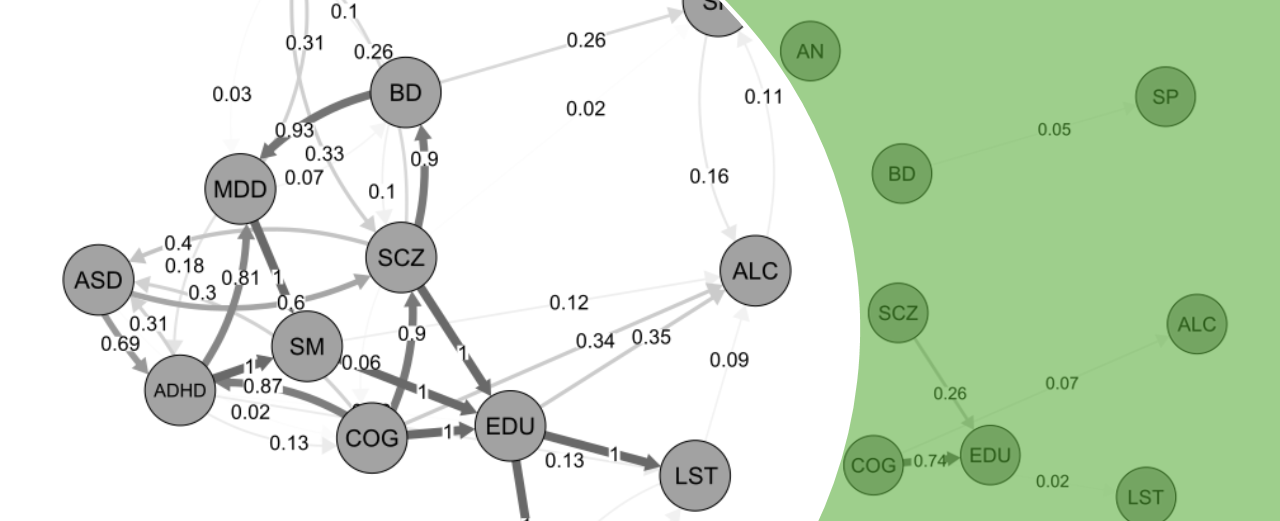MrDAG: Mendelian randomization for multiple exposures and outcomes with Bayesian Directed Acyclic Graphs exploration and causal effects estimation
This R-package introduces MrDAG model, a two-sample summary-level Mendelian randomization(MR) method which explicitly models dependency relations within the exposures, the outcomes and between them by using Bayesian Directed Acyclic Graphs (DAGs) to improve the detection of causal effects.
The development of MrDAG was motivated to uncover complex and sometimes reciprocal relationships among lifestyle and behavioural exposures that impact mental health phenotypes.
MrDAG combines three causal inference strategies:
- First, it uses genetic variation as instrumental variables to account for unmeasured confounders;
- Second, it performs structure learning to detect and orientate the direction of the dependencies within exposures and outcomes;
- Third, interventional calculus is employed to derive causal effect estimates.
The implementation of MrDAG is fully Bayesian. It allows us to model the uncertainty regarding which graphical models, under the constraint of edges' orientation from the exposures to the outcomes, best describe the underlying dependency structure in a given data set and it conveys this uncertainty into the estimation of the causal effects.
MrDAG returns the explored DAGs which belong to Markov Equivalent Classes whose unique representative chain graphs are the Essential Graphs, the posterior probability of edge inclusion (PPEI) of the explored DAGs and the posterior (average) causal effects under intervention on the exposures.
Two data sets are included in the R-package:
- The first data set (LBT2MD_data) contains lifestyle and behavioural traits that are considered exposures of the risk of mental health phenotypes. As outcomes, seven mental health phenotypes are considered, including (in alphabetic order) attention deficit hyperactivity disorder (ADHD), anorexia nervosa (AN), autism spectrum disorder (ASD), bipolar disorder (BD), cognition (COG), major depressive disorder (MDD) and schizophrenia (SCZ). As exposures, six lifestyle and behavioural traits that have previously been investigated for their protective/risk effects on mental health are considered, including (in alphabetic order) alcohol consumption (ALC), education (in years) (EDU), leisure screen time (LST), physical activity (PA), lifetime smoking index (SM) and sleep duration (SP). 708 independent Instrumental Variables (IVs) are selected to be associated at genome-wide significance with the exposures after clumping;
- The second data set (MD2LBT_data) reverses the definition of exposures (mental health phenotypes) and outcomes (lifestyle and behavioural traits) to perform reverse causation analysis. It consists of 470 independent IVs selected to be associated at genome-wide significance with the exposures after clumping.
The installation of MrDAG requires the following steps:
-
Install the devtools package. This can be done from CRAN. Invoke R and then type
install.packages("devtools") -
Load the devtools package
library("devtools") -
Install MrDAG package by typing
devtools::install_github("lb664/MrDAG") -
Finally, load the MrDAG package
library("MrDAG")
The first example concerns the analysis of lifestyle and behavioural exposures that might impact mental health phenotypes. After loading the data set
data(LBT2MD_data)
the indices of the traits that define the outcomes and exposures are provided in a list object
MrDAGcheck <- NULL
MrDAGcheck$Y_idx <- 1 : 7 # Mental health phenotypes
MrDAGcheck$X_idx <- 8 : 13 # Lifestyle and behavioural traits
and MrDAG algorithm is run to generate 1,000 posterior samples of all unknowns
output <- MrDAG(data = LBT2MD_data,
niter = 5000, burnin = 2500, thin = 5,
tempmax = 20, w = 0.01,
MrDAGcheck = MrDAGcheck, filename = NULL)
with 0.01 prior probability of edge inclusion. Finally, the posterior probabilities of edge inclusion (PPEIs) are calculated and presented in a data matrix with lifestyle and behavioural traits first, followed by mental health phenotypes
ord <- c(8 : 13, 1 : 7)
PPEI <- get_edgeprob(output, ord = ord)
Warning! In Example 1, the number of iterations is set at 5,000 with 2,500 for the burn-in (overall, 7,500 iterations). However, to obtain reliable results in real data applications and analysis, the number of iterations should be much larger. We recommend running the algorithm at least for 100K iterations and 10K for the burn-in.
This second example performs the analysis of the same data set for reverse causation to explore whether mental health phenotypes might affect lifestyle and behavioural traits. After loading the data set
data(MD2LBT_data)
the indices of the traits that define the outcomes and exposures are provided in a list object
MrDAGcheck <- NULL
MrDAGcheck$Y_idx <- 1 : 6 # Lifestyle and behavioural traits
MrDAGcheck$X_idx <- 7 : 13 # Mental health phenotypes
and MrDAG algorithm is run to generate 1,000 posterior samples of all unknowns
output <- MrDAG(data = MD2LBT_data,
niter = 10000, burnin = 5000, thin = 10,
tempmax = 20, w = 0.01,
MrDAGcheck = MrDAGcheck, filename = NULL)
with 0.01 prior probability of edge inclusion. Finally, the (average) causal effects and 90% credible intervals are estimated
causaleffects <- get_causaleffects(output, CI = 0.90, progress = TRUE)
showing on the screen the progress of the causal effects estimation.
Warning! In Example 2, the number of iterations is set at 10,000 with 5,000 for the burn-in (overall, 15,000 iterations). However, to obtain reliable results in real data applications and analysis, the number of iterations should be much larger. We recommend running the algorithm at least for 100K iterations and 10K for the burn-in.
This software uses the GPL v2 license, see LICENSE. Authors and copyright are provided in DESCRIPTION
To report an issue, please use the MrDAG issue tracker at BugReports
